“Price is what you pay. Value is what you get.” – Warren Buffett
Price is definitely not the same as value, although classical economics continues to assume it is. In their rational models, economists (and many researchers) believe that humans are calculating machines summing up the costs and benefits of a decision with perfect information and reaching a rational conclusion (so-called Homo Economicus).
The reality is quite different, in that many of our decisions are habitual (automated) and those that aren’t are most often made by using simple heuristics (mental rules of thumb) as proxies for more effortful analysis of what to do.
That doesn’t imply that we are irrational. Quite the opposite. Our brains are very very good at taking a life-time of experiences and estimating the likely outcomes of different courses of action based on (arguably Bayesian) probabilistic calculations. But these calculations are done outside our conscious awareness.
The number of ‘cognitive biases’ (a pejorative term for heuristics) in the literature can seem overwhelming (in the hundreds when I last checked the Wikipedia article). That’s why TapestryWorks have simplified these heuristics into five overall themes that explain much of human decision-making. One of the most important areas of decision-making revolves around what we buy, so let’s look at how these rules apply to the psychology of money.
The five themes are that we like to keep things SIMPLE, we follow NORMS, we are biased to information that is more mentally AVAILABLE, we interpret experience through a very PERSONAL lens and, most importantly of all, the brain’s main purpose is to seek PATTERNS in the world, from which it can extract meaning. We have even created a card game around these five themes that can be used as a creative stimulus in workshops and as a learning tool (please get in touch if you would like to know more).
Let’s start with the need to keep things SIMPLE. Price is all about choices, but choice comes with a paradox. If you ask anyone here, including me, if they would like more choice, they will always say yes. However, all the research shows that when faced with more choice, decision-making gets harder and satisfaction with our choices decreases. In fact, when there are too many choices decision-making often breaks down, as the easiest choice is to do nothing.
The best example of this comes from real-life. Procter & Gamble found out that they had 24 SKUs of detergent in one market. When they reduced this to 15, their total sales went up by 10% (and they saved money too).
A similar pattern has been shown in other categories and in more laboratory-based experiments. In one experiment with choices of pen, the optimal number of choices was around 10 items, with the number of participants making a purchase dropping with more choice.
However price differences can help when items are similar. We can find it difficult to choose on the basis of small differences across features. In such cases, introducing a small price difference can help people to make up their mind. An interesting finding when many brands tend to price at parity with their competitors. Psychologically, introducing a small price difference focuses our mind on this difference, reducing the perceived difference in other features.
Decision-making is NORMATIVE too. We like to follow what other people are doing and thinking, and when you don’t know the best choice, following the most popular among your peers seems like a very sensible choice.
In fact, social norms are often more effective than money in motivating people to do what you would like them to do. One study showed that introducing small fines for parents who were late to pick up their children from a day care centre actually increased the number late. Previously, they had been on time because they didn’t want to let someone down, but now they could pay a small fee to clear their conscience.
Another experiment showed that voluntary contributions to a charity box (for purchase of milk in a canteen) increased when people felt that they were being watched. In reality, the only difference was a picture of eyes on the wall, instead of a picture of flowers, but donations were almost three times as much when the picture included a face and eyes.
Norms are shaped by culture and context too. In another experiment, participants were painted a scenario about being on a beach on a hot day. A friend is offering to buy them a beer, either from a run-down corner shop or a hotel bar. How much would they be willing to pay? Unsurprisingly, a beer from a hotel bar is worth a lot more than a beer from a small grocery store.
Of course, you probably see this effect everyday at Starbucks and similar coffee shops. Perhaps the best example of context and price is the strange fact that Rolls-Royce spend a large part of their marketing budget on attending boat shows? Why do they do that? I guess that after seeing a range of million dollar yachts then the price of a luxury car seems like a giveaway.
Making yourself mentally and physically AVAILABLE is the key to successful branding. Behavioural science shows that things and events that are vivid are much more likely to be recalled and are seen to be more likely than they really are.
There is a lot of evidence in branding and advertising too about the most effective ways to build mental availability and that evidence points to the importance of emotions in building brand value. Thinking about price, analysis of effective advertising over the years shows that emotional advertising is much more effective in showing long-term effects on price elasticity. That is, building emotional connections with your brand means that you can charge more.
Emotions increase sales volume if such associations are built consistently over time and such advertising works very differently from the short-term effects of rational messaging which produce much more immediate sales, but have no long-term effect (and in the case of promotions can have some negative effects on brands).
This is supported by some recent analysis of brand value growth over the last ten years. The analysis shows that brands with poor branding but strong advertising do only slightly better than brands with poor branding and poor advertising (27% versus 21%). However, strong brands, even when they have poor advertising, grow at a much higher rate (76% in the analysis). This is also when strong advertising is most effective, doubling long-term value growth in combination with a strong brand (168% growth).
Two more free tips on availability. The label “free” has a powerful effect on people, suggesting immediate benefits with no pain attached (see below). Also scarcity has a powerful effect in increasing perceptions of value, and can be suggested by limited time or amounts in promotional offers.
Talking of pain brings me to the way in which decision-making and money are seen through a very PERSONAL lens. We all like to maintain a positive and consistent view of our behaviour, even though we sometimes do things that conflict with our beliefs. We also tend to evaluate based on the level of involvement or personal ownership that we feel, which is why we value our personal coffee mug much more than its replacement value and just the ability to touch items in a store increases the likelihood of purchase.
Choices are all about balancing the pleasures of benefits with the pain of buying. We feel paying as psychological pain, as money is seen as much more tangible than other forms of paying. By contrast, we don’t view credit cards in the same way. Studies of shopping baskets and buyer behaviour have shown that purchases of healthy food increase when people pay cash, whereas purchases of junk food increase when people pay with credit.
The most famous theory in behavioural economics is Prospect Theory, which includes the idea of loss aversion. There are many examples showing that humans are much more sensitive to losses than gains (losses have at least twice the psychological impact of equivalent gains). In one of Daniel Kahneman’s experiments, he showed that people who already owned a simple mug, valued it far more highly than people who were asked to bid for the mug (‘sellers’ wanted more than twice as much to sell their mug as ‘buyers’ were prepared to offer for a mug that they didn’t yet own).
The final theme is PATTERNS. The brain is a pattern recognition machine, and this is seen most clearly in placebo effects, when even “sugar pills” produce a tangible impact on our bodies.
Dan Ariely and his co-workers have conducted some interesting experiments on placebo effects in marketing. In this example, they asked participants to buy an energy drink and then complete a number of puzzles and mental tests. When the energy drink was discounted, participants completed fewer puzzles, although there was no difference in the drinks. The only difference was in the expectations of the drinkers.
Patterns are also seen clearly in the way we respond to the presentation of numbers and prices. When an ad for a dress was included in a catalogue with different price points and sent out to equal numbers of people for each price, the number of purchasers was highest for the $39 price point, higher than either $44 or even $34.
It’s not completely understood why charm prices work. Perhaps it is because they are more precise, perhaps because they are associated with discounts or even because of the way that the brain tends to bundle information, so that a price of $39 is in the category “under 40”. Although charm pricing and the power of 9 often work, there are occasions when rounded numbers are more effective and some recent studies have shown that rounded numbers are processed more quickly in the brain and can lead to a subjective experience of “feeling right”. This might work better for more emotional purchases, where you don’t want the rational brain to get involved in evaluating the price. When numbers are very precise and non-rounded we have to think much more about what they mean.
Let me finish with a more bizarre example of priming. If you take a look at these labels, which do you think is the best price? Of course, the answer is that it depends, but studies have shown that (at least for European cultures), numbers and prices are considered smaller if they are in smaller fonts and bigger in larger fonts. Because of then tendency to see numbers on a continuum from left to right (left is smaller, right is bigger), numbers to the left can be seen as smaller too. And of course, numbers that are lower also “feel” lower than numbers that are higher.
To summarise my five key points:
Reducing options makes choice more SIMPLE
Social NORMS are often more powerful than money
Be mentally AVAILABLE to increase brand value
PERSONALISATION increases perceived value
Use PATTERNS to prime expectations
Above all, these examples show that price perception is relative and we don’t know what things really cost, our perceptions of value change depending on the situation and that price isn’t just another feature of brands, but an intrinsic part of shaping expectations. Price is all about understanding context. If you want sensible answers in pricing research (indeed any research), make sure you set the right context.






Framing Prices for SNAPP Decisions – TapestryWorks
[…] my last post on the psychology of money (click here), I looked at pricing through the lens of the SNAPP behaviour framework. I left out many examples […]
The Psychology of Payments – TapestryWorks
[…] have written often on the psychology of money (click here, here and here). A recent study of payments answers some of my outstanding questions about the […]